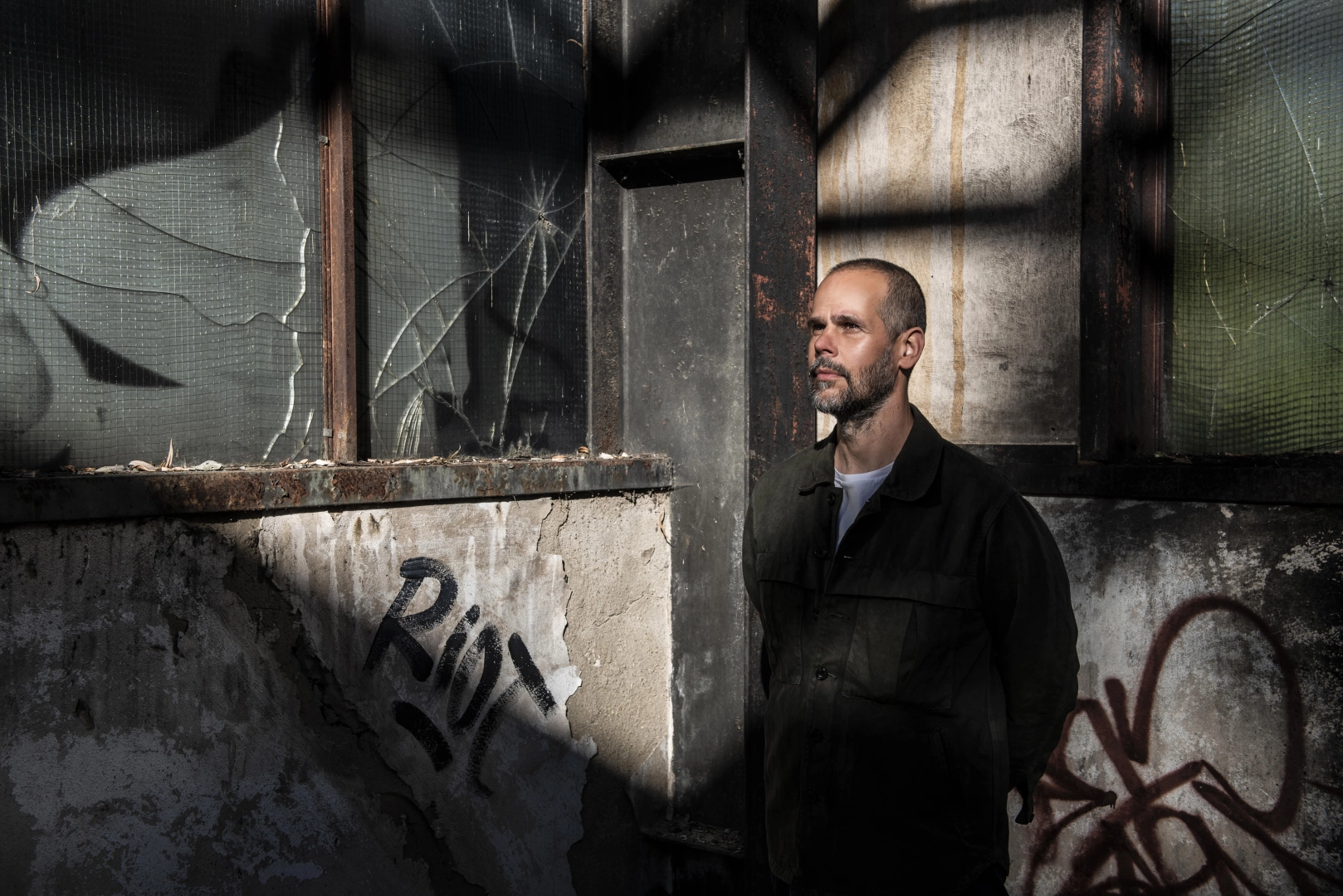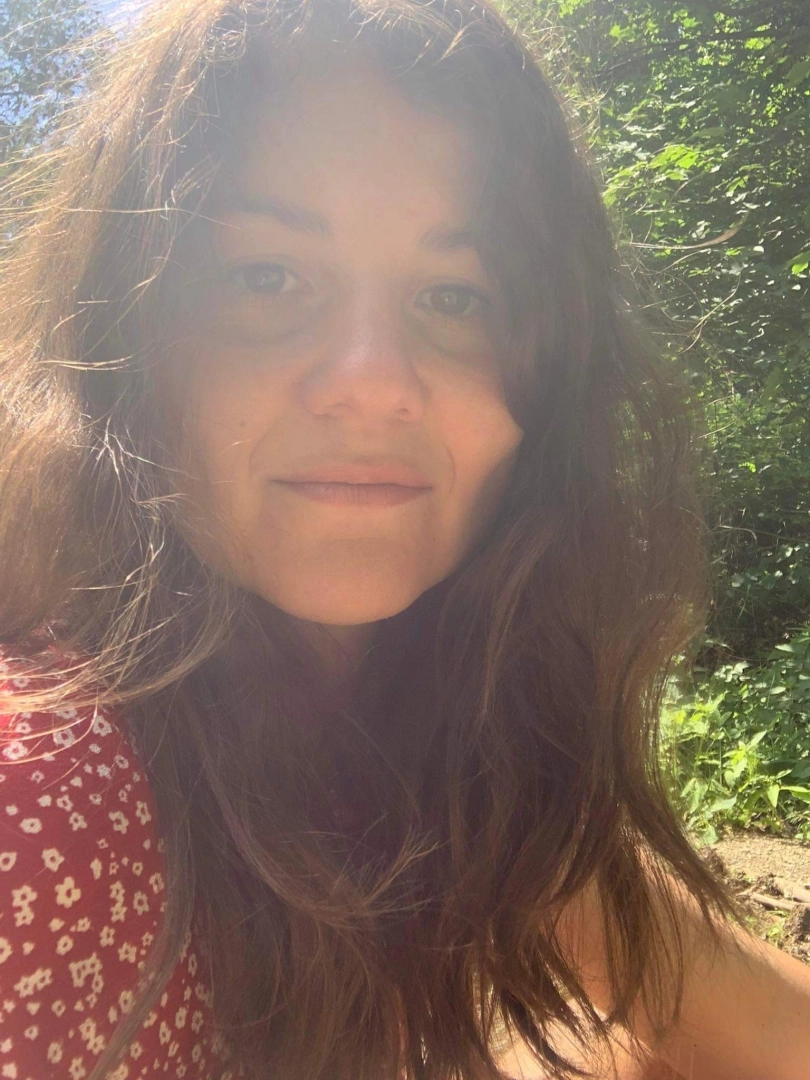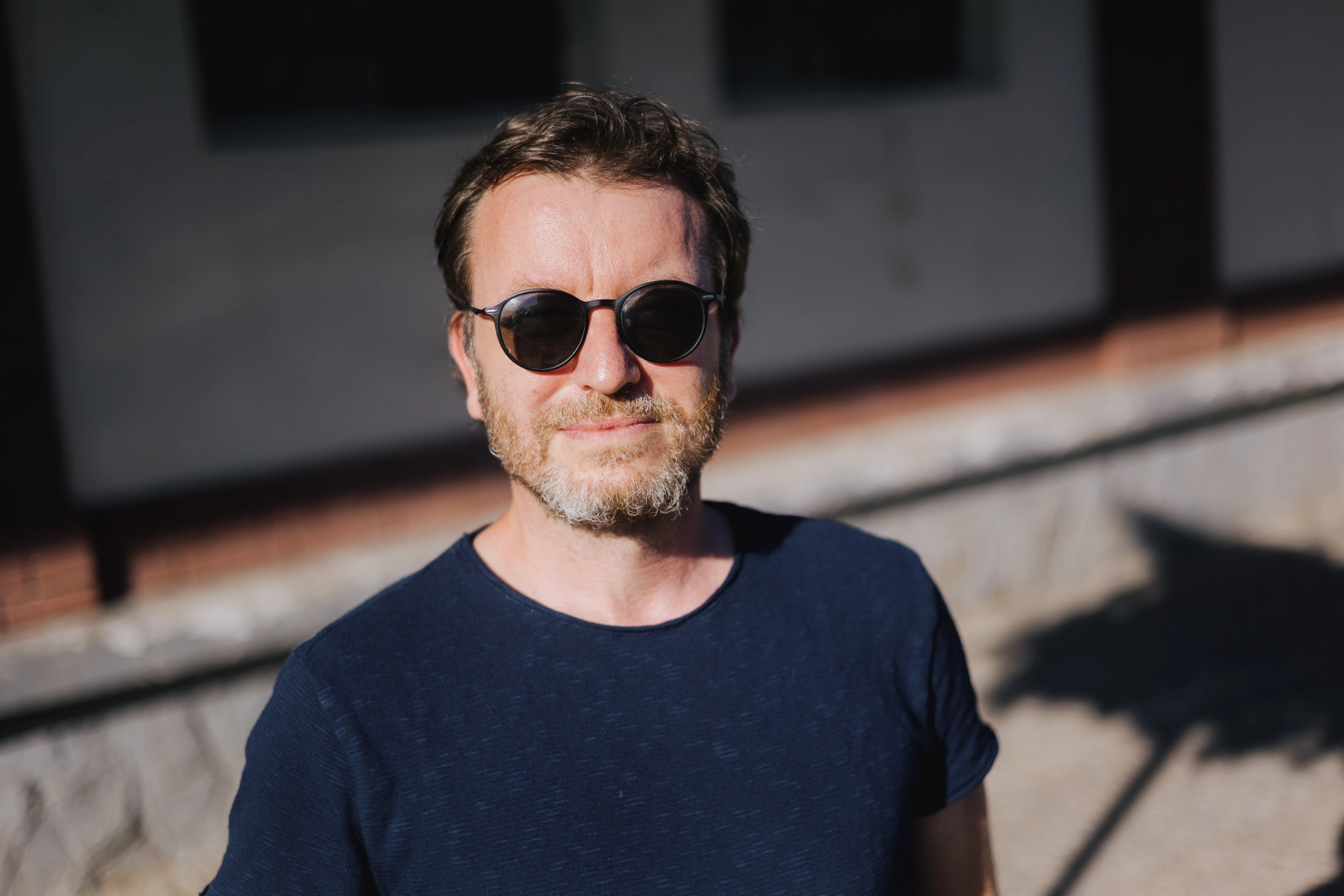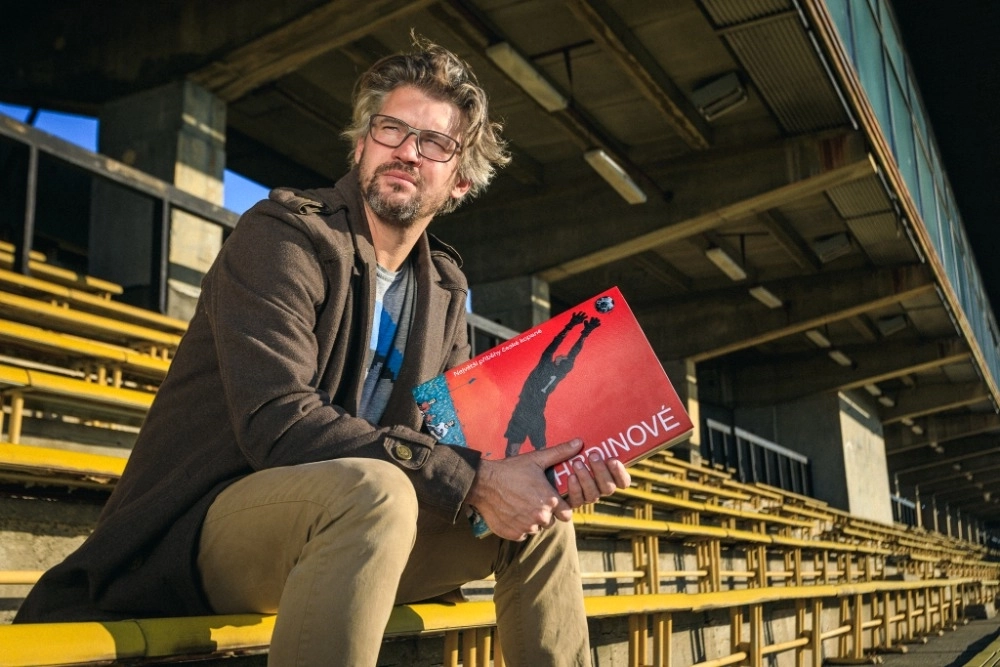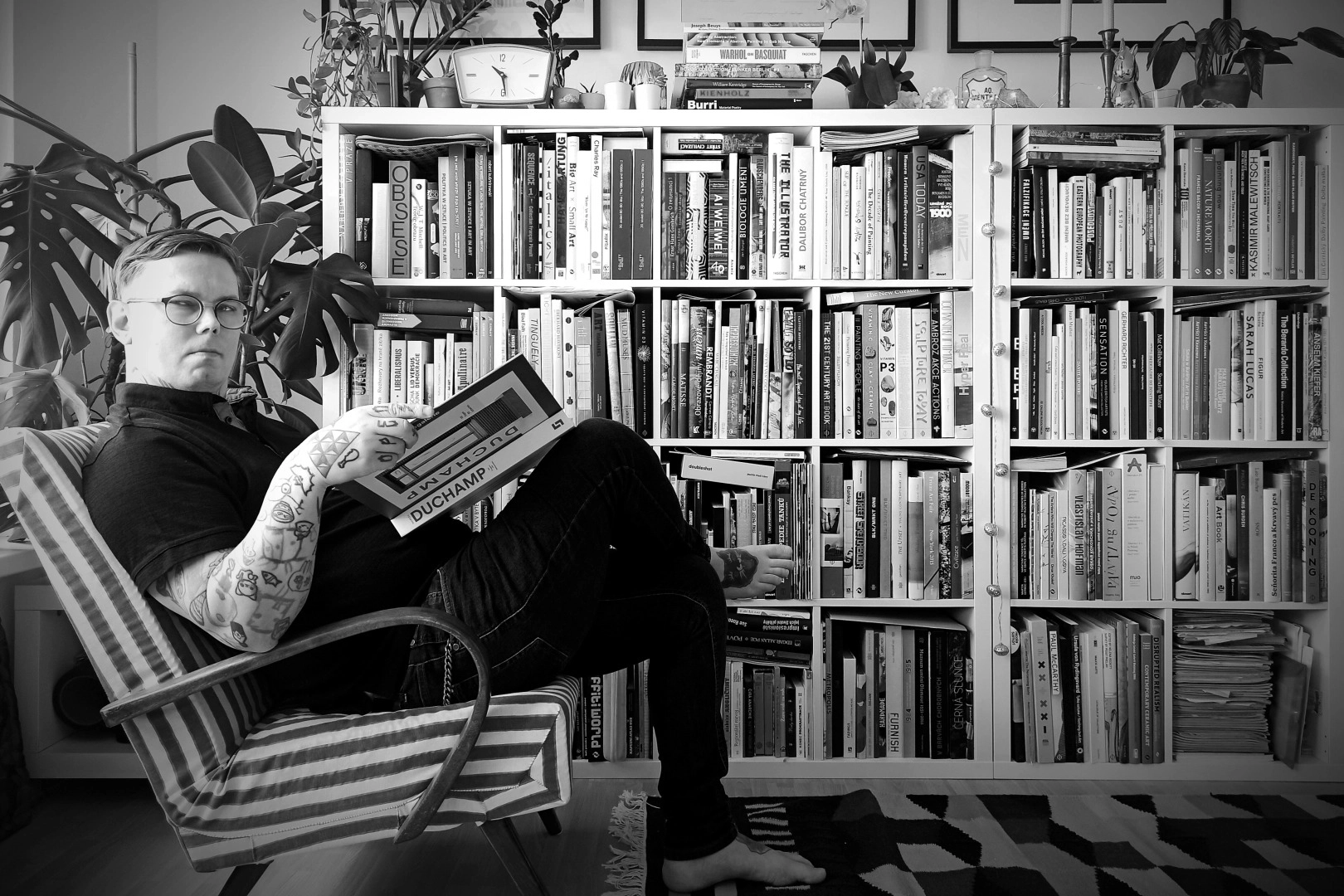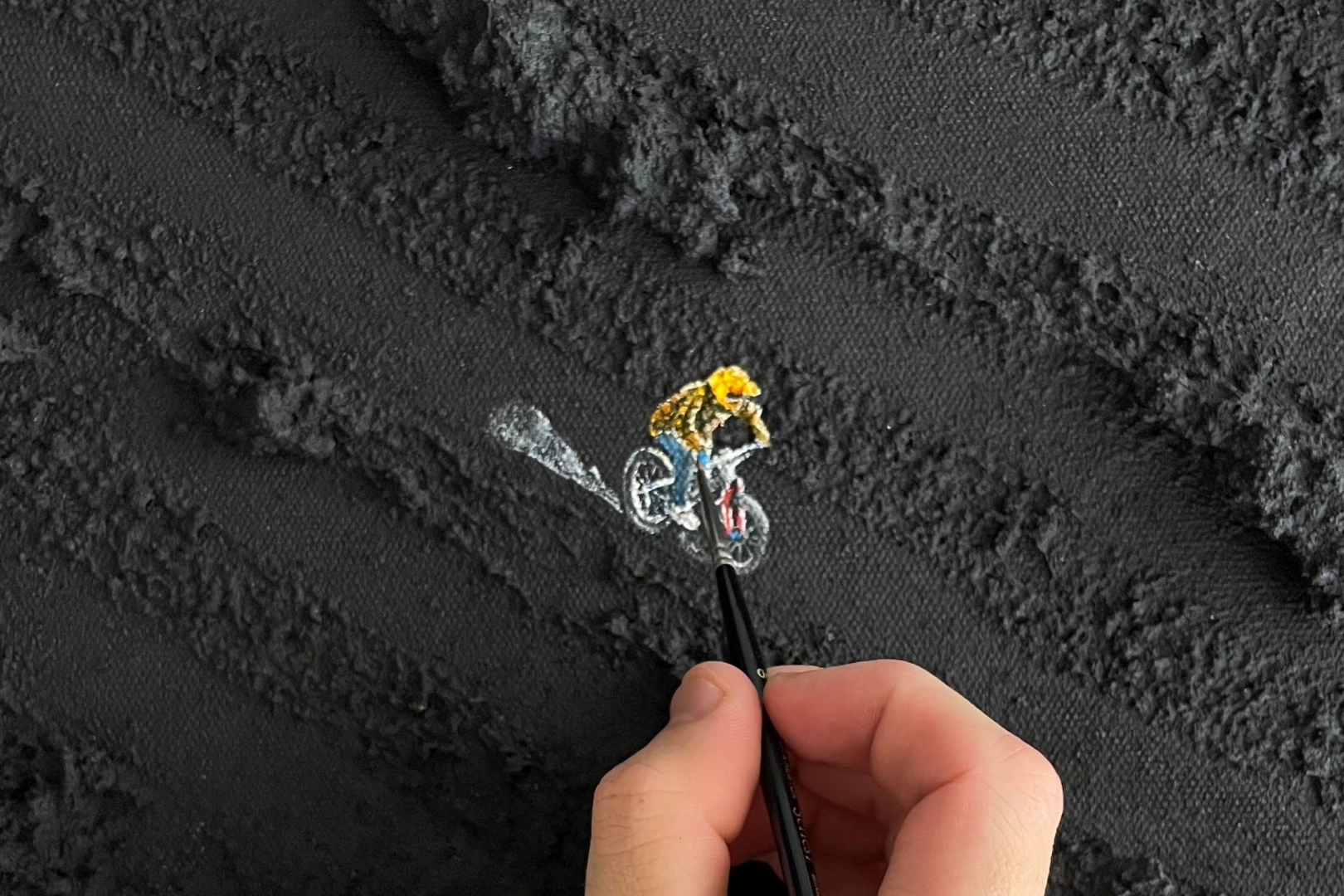Federico Díaz uses his art to draw attention to ways in which our view of the world changes in connection to new technologies. For example, the sculpture Aerial (Na Horu) unveiled in 2021 in Bořislavka, Prague, was created by programmed robots and represents a piece of simulated nature towering in the centre of the local business centre. The topic of many of Díaz’s works is also movement which is why he became an ideal respondent of our magazine. Right before our interview, he went for a swim in the Vltava river.

The topic of sport and movement is often pervasive in your work. According to you, what role does sport play in today’s society? What does it ritually represent?
People are fascinated by speed. We continuously push the limits of possibility. This is something I touched upon in the Fluid F1 project. My view of the formula pilots is connected to ritual dance, where even changing the tires is connected to the predetermined movement, there can’t be any mistakes. When we look at the real ritual dances of indigenous nations - in most cases they contain movements and gestures imitating some sort of custom but they also reflect the mechanics of a skeleton which can belong to a heron, a monkey… Even if the dance is spontaneous or tries to imitate the movement of an animal or the wind, it is still determined by the mechanics of a skeleton. When the F1 is getting a gas refill, the movement is carried out by human beings who have their limitations but also most of them are fascinated by speed.
It’s similar to athletic competitions. We perceive the overcoming of the limits of the body. It’s about complete focus that takes place outside of our consciousness. In the past, we were fascinated by Carl Lewis who broke the 10-second limit in the 100-metre sprint but nowadays it’s more about fractions of a second. We are fascinated by speed both consciously and unconsciously. The body has its limitations that we’re constantly trying to overcome. We work on bettering ourselves which is connected to diet and discipline. We know a lot about the human body, and we try to alter it and overcome our limits. With Formula 1 it’s the gas that contains information, with the human body it’s food. If the information from the food is of good quality, then our tendons, muscles and blood also have that information.
.jpg)
a.jpg)
What role do sport and exercise play in your life?
Exercise, sports and the community around them have helped me overcome many hardships in my life - from athletics, pole jump, decathlon, marathons and recently swimming in the Vltava river which keep me in a good physical and mental condition.
You have a three-year-old son, do you also encourage him to exercise?
Most children don’t like to sit around, so currently we only support his natural desire to move around. But I teach him how to correctly move his arms, for example, which will help him coordinate the rest of his body. The arms balance out the body’s centre of gravity, although I don’t tell him that. I just remind him: “Ruben, your arms”. His eyes always start to glisten and I can see he’s happy I’ve reminded him because it means he can run faster. Most children start running wrong, without using their arms. Since I was young I was taught how to run correctly, although it’s hard to say what ‘running correctly’ is - a native hunter will run differently than an athlete. Considering I used to do athletics, I know how to correctly bend my knees and when to flex and relax which muscle. But I can’t explain that to a three-year-old. So I just tell him how to help himself with his arms.
My five-year-old son often complains that he runs slower than his peers.
Then start with his arms. Tell him not to leave his arms just hanging next to his body, and that he should bend them at a right angle. When you teach him, he’ll soon be the fastest in the class.
If you don’t mind, I’d like to ask another question about your son. Regarding your work and my current life situation, I’m also interested in what kind of relationship are you building with him concerning new technologies.
My wife and I agree that anything that we currently present him with that simulates reality makes him angry and confused. Whether it’s watching a video or even recording his voice and playing it back to him, using any sort of technology makes him a confused person. Anything that disconnects him from his physical nature. In the same way, you get tired when watching people running on TV, even though you are not moving. Your body goes through an inadequate exchange of bodily substances which don’t reflect reality.

Similarly to when we’re tired from travel although our bodies are not moving?
Yes, that’s very similar. Your body couldn’t even move in hundred-and-fifty kilometres in an hour. If a child starts to experience reality through its substitutions, which are most technologies, they will be confused. A fairytale, on the other hand, whether it’s being told or read, doesn’t simulate reality but creates space for self-realisation and fantasy. Computer games and animation confuse small children in this way. The more technologies simulate reality, the more they hinder the development of a child’s brain. Digital dementia is extremely dangerous for an undeveloped brain. I think it would be enough for children to start exploring technologies when they are eleven or twelve.
I don’t think there are many children like that these days…
I started watching TV when I was twelve.
Were your parents very aware of this issue?
No, we simply didn’t have a TV. The only TV that was in the house was on the second floor in the communal room. These days, I am highly involved with technologies so that may be why I am so aware of their downsides since I know them all too well.

When reading Resonance, which is a compilation of all texts about your work and your interviews since 2008, I noticed that you often talk about the importance of mothers in children’s lives but you rarely mention the father. Why is that? Do you consider the father to be less influential in the life of a child?
I don’t think that is the case but I’m certain that the child becomes aware of the father much later. In the first few years, the mother should be fully available and the father should be there to create a safe atmosphere so the mother doesn’t have to think about her self-improvement.
So you think that mothers shouldn’t work during the first few years?
No, they shouldn’t.
What if they become frustrated?
This is an issue deeply seated in the whole society since society needs dependent individuals. The system works on the basis of obedience created by the rhythm of work. We can call this rhythm motivation. Employers have to motivate their employees to rise in their careers. Employers hate losing obedient people. The creation and subsequent loss of this dependence create frustration. Mothers’ frustration also arises from the loss of information, community, and relationships. Developed societies try to consciously include this break and remove any “punishment” in terms of worsened conditions for returning to the system. Higher societies say that this break is feasible and it’s possible to come back. It’s just important to create connectivity and provide the missing information. I believe that such a society then has a better quality. The concept of parental leave doesn’t solve anything, the same thing can affect even men experiencing any kind of crisis, like burn-out, and need to distance themselves from work without repercussions.
According to you, how will the human body change under the influence of technology? Or is it already changing?
Again, it’s about pushing the limits of the human body. And not just the body but also the brain. We are led by our fear of death. Prosthetics, implants, and the development of all these things is motivated by our fear of transience. If you don’t move for three months, you will die. Movement is the simplest definition of life.

I also wanted to ask you about ecology which has been present in your work for many years and which you have also been talking about for several decades, unlike the majority of society which has only become aware of this topic in the last few years. I was wondering if your position on ecology has changed in any way, for example, in connection to the birth of your son.
In 1999 we developed various debates for Forum 2000 together with Václav Havel, Zdeněk Neubauer and others. The questions are still the same. In 2000, when I used the term ecology nobody understood it. When we talked about solar cells almost no one knew about this technology. Now it’s very common and widespread. Back then, I could’ve considered myself an extremist, like Greta Thunberg. I was the same then. Nowadays I think it’s a shame that her energy is used to divide society, rather than unite it. The force she creates can be manipulated in any way, but that isn’t important. It alienates regular people from perceiving this problem. It moves these issues into elite spheres which is a shame. Different attempts are constantly being made but I realised that if we are thinking about protecting nature, it’s also very arrogant on our part. You can’t protect nature, it’s still so much more complex than we, humans. We only have an inkling about nature but usually all projects that act as though they are protecting nature end up destroying it.
Can you give us an example?
When we talked about this with Václav Cílek he gave me a good example about reforestation. For example, spruces cause a water shortage where they grow. So the human desire to plant trees can be a double-edged sword.
My question, however, was rather if your thinking about ecology has changed after the birth of your son.
I try to lead my son towards awareness of the physical world which is the true world to me. I don’t consider this parallel, technological one that says what we want to look like as people to be true. I’m teaching Ruben how to mimic crows and ravens, I teach him to run in the rain or to watch the Moon at night and to listen to the rustling of leaves. Ruben has manifested in me a kind of complexity, I now feel complete in my relationship with nature. I guess I don’t know how to answer, there isn’t one because I don’t want to say it hasn’t changed me. Because that also isn’t true. I also don’t want to be banal, say that I’m more responsible, etc. At the same time, there are words I think should be said.

Usually when I try to avoid obvious things they end up missing in the interview.
When Ruben was born my narcissistic self-perception changed. But the extreme position on ecology I talked about mellowed out. In 1998 I’d tell you it’s necessary to only drive electric cars but now I don’t think that’s right anymore. Not because I don’t consider electric cars good but because I imagine Mexico where tens of millions of people would lose their jobs because there are dozens of factories. When Greta says: “Let’s stop this right now,” it is hard for me to imagine what would the billion people employed in these factories do. These are people who love the smell of motor oil and who will never be able to requalify. I feel this very strongly, that’s why I don’t find Greta agreeable.
What is your opinion on de-growth?
I love looking at old photos of workers, I love looking at old photos of people who are very well-dressed and their clothes managed to last them twenty, thirty years. This is also connected to social engineering which nowadays claims that quick change is good for us. This means we need to constantly wear something different, buy something different and change all the time. This is what forms the basis of societal “prosperity” today. This kind of social engineering creates unease which is also connected to the quick return of mothers back into the factory and away from their children as I mentioned before.
How does your art relate to your ecological ambitions?
I have founded a company called So concrete. It was created based on my experience with the sculpture project at Bořislavka. Creating a feeling of usefulness in relation to urban and public construction is a part of my practice. This technology was designed to serve architects and the building industry to save up to 60 per cent of concrete. When you are building a wall, it’s optimised so that the robot extruding the concrete pushes out the substance only where necessary, based on commands from the static analysis. The first project created by this technology will be unveiled in Prague on the 7th of September. It is a tram stop at the no.12 terminus. I founded So concrete together with Karlin developer Serge Borenstein, the majority of the team came from the Frederico Díaz Studio which created the Bořislavka sculpture.


What is going to be the next So concrete project?
The next project will also be a tram stop, in Bratislava. We have also been approached by architect Jan Šépka whom we’ll be helping with the construction of the Museum of Art in Olomouc. And there’s more.
What else are you working on apart from So concrete?
We are developing an app based on the principles of AI. The project is called Matérie and it’s based on information analysis from photographs since nowadays almost everyone regularly takes them and they accumulate on our phones or the Cloud. There are thousands of them and they indicate quite a lot about the way each of us perceives the world. This footprint creates an image we leave behind without even realising.
